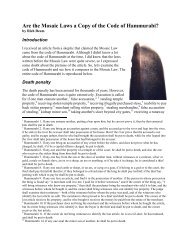DNA Evidence and Molecular Genetics Disprove the Book of Mormon
DNA Evidence and Molecular Genetics Disprove the Book of Mormon
DNA Evidence and Molecular Genetics Disprove the Book of Mormon
You also want an ePaper? Increase the reach of your titles
YUMPU automatically turns print PDFs into web optimized ePapers that Google loves.
<strong>DNA</strong> <strong>Evidence</strong> <strong>and</strong> <strong>Molecular</strong> <strong>Genetics</strong> <strong>Disprove</strong> <strong>the</strong> <strong>Book</strong> <strong>of</strong> <strong>Mormon</strong> page 7 <strong>of</strong> 14<br />
By Rich Deem<br />
Retroviral components<br />
Human populations can become infected with commensal retroviruses that remain in <strong>the</strong> genome<br />
<strong>and</strong> are passed from generation to generation. The human T-cell lymphotrophic retrovirus<br />
HTLV-II is found in Mongolians <strong>and</strong> many Native Americans, but not eastern Siberians. 27 Such<br />
data would be expected if Native Americans originated from Central Asia, as has been found in<br />
<strong>the</strong> o<strong>the</strong>r genetic studies.<br />
Domesticated animals<br />
Native Americans had domesticated dogs in <strong>the</strong>ir settlements. Nearly all <strong>of</strong> <strong>the</strong>se dogs were<br />
wiped out or interbred with European dogs, which were introduced into <strong>the</strong> Americans following<br />
<strong>the</strong> arrival <strong>of</strong> Columbus in 1492. Although no indigenous American dogs exist now, bones from<br />
pre-Columbian sites have been studied to examine <strong>the</strong> genetics <strong>of</strong> those animals.<br />
Scientists extracted <strong>DNA</strong> from <strong>the</strong> bones <strong>of</strong> 37 dog specimens from<br />
archaeological sites in Mexico, Peru, <strong>and</strong> Bolivia, <strong>and</strong> 11 dog remains from<br />
Alaska, all <strong>of</strong> which were deposited before <strong>the</strong> arrival <strong>of</strong> Columbus in <strong>the</strong><br />
New World. 28 Mitochondrial <strong>DNA</strong> sequences isolated from those ancient<br />
dog remains from Latin America <strong>and</strong> Alaska showed that Native American<br />
dogs originated from multiple Old World lineages <strong>of</strong> dogs that<br />
accompanied late Pleistocene humans across <strong>the</strong> Bering Strait.<br />
Genetic Studies - Conclusions<br />
Mesoamerican dog from<br />
200 B.C. - 500 A.D. -<br />
<strong>the</strong>y had fleas even <strong>the</strong>n<br />
The studies cited above represent only a fraction <strong>of</strong> those that have been done on <strong>the</strong> origin <strong>of</strong><br />
Native American populations. The number <strong>of</strong> studies <strong>and</strong> <strong>the</strong> diversity <strong>of</strong> techniques used to<br />
examine <strong>the</strong> origin <strong>of</strong> Native Americans provide overwhelming support that <strong>the</strong> ancestors <strong>of</strong> <strong>the</strong><br />
Native Americans came from Asia. The finding that all five mt<strong>DNA</strong> haplogroups (A-D <strong>and</strong> X)<br />
<strong>and</strong> both Y-chromosome haplogroups (C <strong>and</strong> Q) are found in native populations that inhabit <strong>the</strong><br />
Altai Mountains in southwestern Siberia, suggest that those populations as <strong>the</strong> most likely<br />
ancestor <strong>of</strong> all Native American populations. The initial migration seems to have occurred<br />
between 20,000-15,000 years ago - before <strong>the</strong> emergence <strong>of</strong> <strong>the</strong> prehistoric Clovis sites (13,350-<br />
12,895 year ago) in North America. 29 Because an interior route through nor<strong>the</strong>rn North America<br />
was unavailable for human passage until ~12,550 years ago (after <strong>the</strong> last glacial maximum)<br />
27 Lairmore MD, Jacobson S, Gracia F, De BK, Castillo L, et al. 1990. Isolation <strong>of</strong> human T-cell lymphotropic virus<br />
type 2 from Guaymi Indians in Panama. Proc. Natl. Acad. Sci. USA 87:8840–8844.<br />
Maloney EM, Biggar RJ, Neel JV, Taylor ME, Hahn BH, et al. 1992. Endemic human T cell lymphotropic virus<br />
type II infection among isolated Brazilian Amerindians. J. Infect. Dis. 166:100–107.<br />
Hall WW, Zhu SW, Horai P, Furuta Y, Zagaany G, et al. 1994. HTLV-II infection in Mongolia. AIDS Res. Hum.<br />
Retroviruses 10:443.<br />
Neel JV, Biggar RJ, Sukernik RI. 1994. Virologic <strong>and</strong> genetic studies relate Amerind origins to <strong>the</strong> indigenous<br />
people <strong>of</strong> <strong>the</strong> Mongolia/Manchuria/sou<strong>the</strong>astern Siberia region. Proc. Natl. Acad. Sci. USA 91:10737–10741.<br />
28 Leonard JA, Wayne RK, Wheeler J, Valadez R, Guillen S, Vila C. 2002. Ancient <strong>DNA</strong> evidence for Old World<br />
origin <strong>of</strong> New World dogs. Science 298:1540-1542.<br />
29 Schurr TG, Sherry ST. 2004. Mitochondrial <strong>DNA</strong> <strong>and</strong> Y chromosome diversity <strong>and</strong> <strong>the</strong> peopling <strong>of</strong> <strong>the</strong> Americas:<br />
evolutionary <strong>and</strong> demographic evidence. Am. J. Hum. Biol. 16:420-439.<br />
<strong>Evidence</strong> for God from Science http://www.GodAndScience.org






